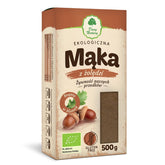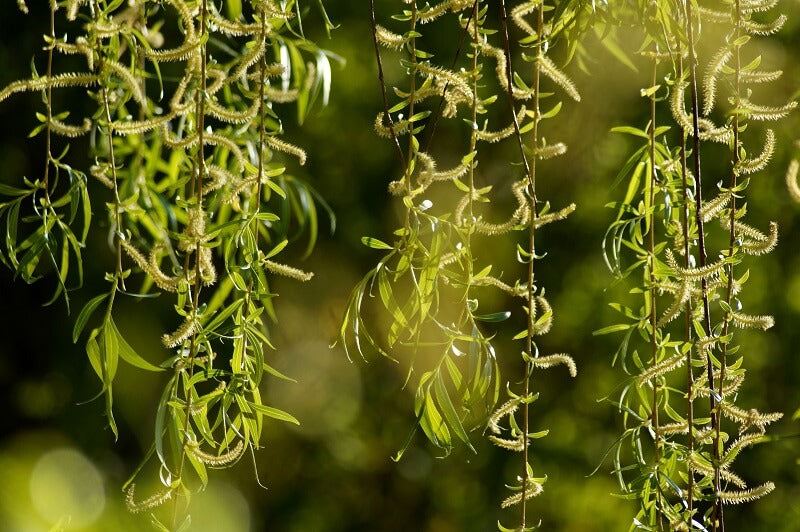White willow – a natural remedy for colds and more
CONTENTS
- White Willow – a handful of information
- White willow bark – the nutritional content
- Willow bark – for pain and various skin problems
- Other uses of white willow bark
- White willow bark – contraindications for use
- Summary
The appearance of the white willow clearly distinguishes it from other trees. Its thick, bulbous trunk, from which towering branches grow, is a common sight in Poland. Therefore, probably all of us are familiar with this tree. In addition to its interesting appearance and widespread presence, it has much more to offer us. Of course, this includes its properties, which can positively affect our body's functions. Salicin—the precursor to the now-popular salicylic acid—was first isolated from the white willow in 1829.
White Willow – a handful of information
The white willow is also called the silver willow or silver willow. It belongs to the willow family and is native to Europe, as well as Asia and some parts of North Africa. In our country, it is a widespread plant and is most commonly found along riverbanks, roadside ditches, and wherever the soil is very moist. Interestingly, the white willow is found almost exclusively in the wild, but its numerous varieties are often cultivated as ornamental plants. One of these is the weeping willow, a very popular tree in parks. The willow has been a valued herbal plant for centuries. In the past, both the bark and leaves, sap, and willow fruits were used. However, currently, practically the only part of the willow used in herbal medicine is the bark. It should be noted, however, that only the young bark of this plant possesses medicinal properties. Therefore, it is harvested for this purpose from 2-3 year-old branches. This should be done in early spring, as the sap circulates more intensively in the tree during this time. This makes it much easier to separate from the wood. White willow bark was already used by the ancient Greeks. Hippocrates mentioned it in his histories. He used it to treat arthritis and as a natural painkiller. However, the true popularity of this raw material only came in the 19th century. At that time, the use of willow bark-based preparations in herbal medicine became widespread.
White willow bark – the nutritional content
Willow bark contains many different active ingredients. It's not called herbal aspirin for nothing. Interestingly, willow bark extract is used to produce this well-known medicine. It consists mainly of salicylic glycosides (salicortin, salicin, populin, fragilin, acetylsalicylin). These decompose in our digestive tract, releasing salicylic alcohol, which then oxidizes to the well-known salicylic acid. It also contains many tannins, phenolic acids, and various resins. It can also be a good source of mineral salts. Examples include potassium, sodium, and iron.
Willow bark – for pain and various skin problems
Thanks to its high content of salicylglycosides, willow bark has analgesic, anti-inflammatory, antipyretic, and antibacterial properties. It can be an excellent and, above all, natural alternative to traditional medications for these common symptoms. It is indicated for colds, flu, and infections of all kinds. It should be remembered that it can also relieve rheumatic pain and specifically support the fight against joint inflammation. It is also worth mentioning that willow bark-based preparations can also be applied externally. They are very effective for skin lesions and can support wound healing. The active ingredients contained in the bark have astringent and disinfectant properties. Willow bark can also help combat stubborn acne. It unclogs pores, soothes skin irritations, and supports the process of removing dead skin cells.
Other uses of white willow bark
Preparations made from white willow bark are also used to relieve insomnia, as well as various neuralgias and migraines. Interestingly, they can also reduce the intensity of premenstrual tension. Furthermore, they have a relaxing effect and are therefore excellent for enteritis or diarrhea. It is also worth knowing that willow bark can have an effect on our cardiovascular system. Its use can significantly reduce the risk of heart attack, as well as other cardiovascular diseases. By inhibiting excessive platelet clumping, it can also reduce the risk of blood clots and arteriosclerosis.
How do you use white willow bark?
By far the most popular way to use white willow bark is as an infusion. To do this, pour a tablespoon of dried willow bark into a glass of boiling water. Then cover the mixture and wait about 15-20 minutes. Willow tea can be consumed this way once or twice a day.
Willow bark tincture is also popular. Its preparation is very simple. About 100 grams of dry bark should be infused with about 500 milliliters of strong alcohol with an alcohol content of approximately 40-60%. The prepared containers are then tightly closed and stored in a dark place for 14 days. After this time, the finished tincture is filtered and bottled. It is recommended to consume one teaspoon, previously dissolved in water, tea, or another beverage, no more than four times a day. Remember that this is an alcoholic solution, and you should not drive after consuming it. The maximum daily dose for adults has been set at 12 grams of pure tincture.
You can also prepare a decoction. To do this, pour in a tablespoon of bark and about 1.5 cups of cold water. Bring the prepared solution to a boil and simmer for 30 minutes. Once the mixture is ready, let it cool for 15 minutes. Strain the finished broth and consume fresh. We try not to exceed 3 glasses per day. You can also use the decoction externally. Soak gauze in it and apply it to the skin as a compress. There's nothing wrong with adding willow bark to your bath. To do this, boil 100 grams of bark powder in a liter of water for 20 minutes. After this time, pour the finished mixture into your bathtub.
White willow bark – contraindications for use
White willow bark is a safe herbal raw material, but there are certain cases where its use should be discontinued immediately. This raw material should primarily be avoided by children. Pregnant and breastfeeding women should consult a doctor before using willow bark preparations. Due to the content of many active ingredients in the bark, including salicylates, interactions with medications may occur. People who are allergic or hypersensitive to salicylates, as well as to nonsteroidal anti-inflammatory drugs, should definitely refrain from using it. Willow bark can also aggravate bronchial asthma. Contraindications to its use include various liver and kidney diseases, blood clotting problems, and stomach or duodenal ulcers.
Summary
White willow bark is rich in salicylates and can act as a natural analgesic, fever-reducing, or anti-inflammatory medication. However, this isn't the end of its potential uses. It also works as a remedy for acne, various wounds, and is a preventative against cardiovascular diseases. Thanks to its high active ingredient content, it has a broad spectrum of effects on the human body. However, we should consider the potential risks and contraindications when using willow bark. Because wherever we deal with active ingredients, potentially dangerous interactions can occur.
THE PUBLISHER'S CHOICE
Dried plums 1 kg BIOGO
- £6.06
- £6.06
- Prezzo unitario
- / per
Dried White Mulberries 500 g ORGANIC
- £5.05
- £5.05
- Prezzo unitario
- / per
Almonds 1 kg BIOGO
- £10.11
- £10.11
- Prezzo unitario
- / per
Cranberries sweetened with apple juice organic 1 kg BIOGO
- £14.16
- £14.16
- Prezzo unitario
- / per
Dried dates 1 kg BIOGO
- £3.64
- £3.64
- Prezzo unitario
- / per
Unpeeled buckwheat groats 1 kg BIOGO
- £2.43
- £2.43
- Prezzo unitario
- / per
Walnuts 800 g BIOGO
- £7.48
- £7.48
- Prezzo unitario
- / per
Peeled sunflower seeds 1 kg BIOGO
- £2.63
- £2.63
- Prezzo unitario
- / per
PULLED ORGANIC SUNFLOWER SEEDS 1 KG BIOGO
- £3.84
- £3.84
- Prezzo unitario
- / per












































































































































